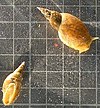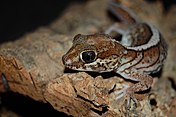Lista de animais por número de neurônios
A tradução deste artigo está abaixo da qualidade média aceitável. (Outubro de 2022) |
A seguir estão duas listas de animais ordenadas pelo tamanho de seu sistema nervoso. A primeira lista mostra o número de neurônios em todo o sistema nervoso, indicando sua complexidade neural geral. A segunda lista mostra o número de neurônios na estrutura que foi considerada representativa da inteligência animal.[1] O cérebro humano contém 86 bilhões de neurônios, com 16 bilhões de neurônios no córtex cerebral.[2][1]
Resumo[editar | editar código-fonte]
Neurônios são as células que transmitem informações no sistema nervoso de um animal para que ele possa sentir estímulos de seu ambiente e se comportar de acordo. Nem todos os animais têm neurônios; Trichoplax e esponjas não possuem quisquer células nervosas.
Os neurônios podem ser compactados para formar estruturas como o cérebro dos vertebrados ou os gânglios neurais dos insetos.
Sistema nervoso inteiro[editar | editar código-fonte]
Todos os números para neurônios (exceto Caenorhabditis e Ciona) e todos os números para sinapses (exceto Ciona) são estimativas.
Lista de espécies animais por número de neurônios do prosencéfalo (ou pálio)[editar | editar código-fonte]
| Nome comum | Número médio de estruturas neurais sensoriais-associativas [a] | Variação intraespecífica [b] | Método[c] | Estrutura sensorial-associativa | Nomenclature binomial | Imagem | Fonte |
|---|---|---|---|---|---|---|---|
| Mosca de fruta | 2,500* | Facionador ótico | Corpora pedunculata | Drosophila melanogaster |  |
[37] | |
| Cachalote-pigmeu | 2,020,000,000* | Facionador ótico | Pálio (córtex) | Kogia breviceps |  |
[38] | |
| Foca-leopardo | 2,386,000,000^ | Estimado | Pálio (córtex) | Hydrurga leptonyx |  |
[39] | |
| Guenon | 2,500,000,000^ | Estimado | Pálio (córtex) | Genus: Cercopithecus, espécie desconhecida |  |
[40] | |
| Macaca nemestrina | 2,531,000,000^ | Estimado | Pálio (córtex) | Macaca nemestrina | 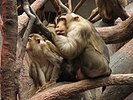 |
[39] | |
| Theropithecus gelada | 2,568,000,000^ | Estimado | Pálio (córtex) | Theropithecus gelada |  |
[39] | |
| Arara vermelha | 2,646,000,000^ | Estimado | Pallium (DVR) | Ara chloropterus |  |
[39] | |
| Toninha-comum | 2,750,000,000* | Facionador ótico | Pálio (córtex) | Phocoena phocoena |  |
[39][41] | |
| Papio cynocephalus | 2,880,000,000 | Facionador isotrópico | Pálio (córtex) | Papio cynocephalus |  |
[42] | |
| Arara-azul-grande | 2,944,000,000^ | Estimado | Pallium (DVR) | Anodorhynchus hyacinthinus |  |
[39] | |
| Babuíno-sagrado | 2,990,000,000^ | Estimado | Pálio (córtex) | Papio hamadryas |  |
[39] | |
| Mandril | 3,102,000,000^ | Estimado | Pálio (córtex) | Mandrillus sphinx | 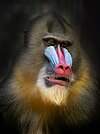 |
[39] | |
| Morsa | 3,929,000,000^ | Estimado | Pálio (córtex) | Odobenus rosmarus |  |
[39] | |
| Elefante-marinho-do-sul | 3,994,000,000^ | Estimado | Pálio (córtex) | Mirounga leonina |  |
[39] | |
| Elefante africano | 5,600,000,000 | Facionador isotrópico | Pálio (córtex) | Loxodonta africana |  |
[43] | |
| Golfinho comum | 6,700,000,000* | Facionador ótico | Pálio (córtex) | Delphinus delphis |  |
[39][38] | |
| Elefante asiático | 6,775,000,000^ | Estimado | Pálio (córtex) | Elephas maximus |  |
[39] | |
| Bonobo | 7,250,000,000^ | Estimado | Pálio (córtex) | Pan paniscus |  |
[39] | |
| Chimpanzé | 7,400,000,000* | Facionador ótico | Pálio (córtex) | Pan troglodytes |  |
[44] | |
| Orangutango | 7,704,000,000^ - 8,900,000,000^ | Estimado | Pálio (córtex) | Genus: Pongo | 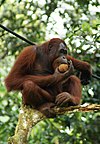 |
[39][45] | |
| Gorila | 9,100,000,000^ | Estimado | Pálio (córtex) | Gorilla gorilla | 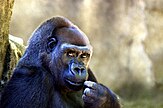 |
[39][45] | |
| Baleia-bicuda-de-cuvier | 9,100,000,000* | Facionador ótico | Pálio (córtex) | Ziphius cavirostris |  |
[38] | |
| Baleia-branca | 10,000,000,000^ | Estimado | Pálio (córtex) | Delphinapterus leucas |  |
[39] | |
| Golfinho-roaz | 12,700,000,000* | Facionador ótico | Pálio (córtex) | Tursiops truncatus |  |
[39][38] | |
| Baleia-de-minke | 12,800,000,000* | Facionador ótico | Pálio (córtex) | Balaenoptera acutorostrata |  |
[46] | |
| Baleia-comum | 15,000,000,000* | Facionador ótico | Pálio (córtex) | Balaenoptera physalus | 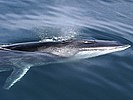 |
[39][47] | |
| Baleia-azul | 15,000,000,000^ | Estimado | Pálio (córtex) | Balaenoptera musculus |  |
[39] | |
| Humano | 16,340,000,000
21,000,000,000* |
± 2,170,000,000[36] | Facionador isotrópico
Facionador ótico |
Pálio (córtex) | Homo sapiens |  |
[36][48][1][49][50] |
| Golfinho-de-risso | 18,750,000,000^ | Estimado | Pálio (córtex) | Grampus griseus | 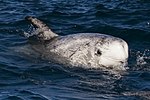 |
[39] | |
| Baleia-piloto-de-aleta-curta | 35,000,000,000^ | Estimado | Pálio (córtex) | Globicephala macrorhynchus |  |
[39] | |
| Baleia-piloto-de-aleta-longa | 37,200,000,000* | Facionador ótico | Pálio (córtex) | Globicephala melas |  |
[51] | |
| Baleia orca | 43,100,000,000* | Facionador ótico | Pálio (córtex) | Orcinus orca |  |
[39][38] |
A questão de qual característica física de um animal torna um animal inteligente variou ao longo dos séculos. Uma especulação inicial foi o tamanho do cérebro (ou peso, que fornece a mesma ordenação). Uma segunda proposta era a razão cérebro-massa corporal e uma terceira era o quociente de encefalização, às vezes chamado de QE. O melhor preditor atual é o número de neurônios no prosencéfalo, com base nas contagens de neurônios aprimoradas de Herculano-Houzel.[1] Ele explica com mais precisão as variações na dependência do cerebelo. O elefante depende de seu cerebelo excepcionalmente grande, enquanto os pássaros se contentam com um muito menor.
Diferentes métodos têm sido usados para contar neurônios e estes podem diferir em grau de confiabilidade. São eles o fracionador óptico, uma aplicação da estereologia, e o fracionador isotrópico, uma inovação metodológica recente. A maioria dos números na lista é resultado de estudos usando o fracionador isotrópico mais recente.[1][52][26][53][54][55][56][42][57][58][59][45][48][60][43][61] Uma variação do fracionador óptico foi responsável pela contagem anterior total de neurônios do cérebro humano de 100.000.000.000 neurônios, que foi revisada para 86.000.000.000 pelo uso do fracionador isotrópico. É em parte por isso que pode ser considerado menos confiável. Finalmente, alguns números são o resultado de estimativas baseadas em correlações observadas entre o número de neurônios corticais e a massa cerebral em táxons intimamente relacionados.
Ver também[editar | editar código-fonte]
Notas
- ↑ ^ = Estimated
Predefinição:Asterisk = Optical fractionator - ↑ ± standard deviation
- ↑ For the estimated values, the numbers of cortical neurons estimated from brain mass for different mammalian and bird orders are based on correlation observed between number of cortical neuron and brain mass per order[36]
Referências
- ↑ a b c d e Herculano-Houzel S (9 de novembro de 2009). «The human brain in numbers: a linearly scaled-up primate brain». Frontiers in Human Neuroscience. 3. 31 páginas. PMC 2776484
 . PMID 19915731. doi:10.3389/neuro.09.031.2009
. PMID 19915731. doi:10.3389/neuro.09.031.2009
- ↑ «How many neurons make a human brain? Billions fewer than we thought». The Guardian. 28 de fevereiro de 2012 Verifique o valor de
|display-authors=Randerson J(ajuda) - ↑ Sherwood L, Klandorf H and Yancey P (2012) Animal Physiology: From Genes to Organisms Cengage Learning, p. 150. ISBN 9781133709510.
- ↑ Smith CL, Pivovarova N, Reese TS (2015). «Coordinated Feeding Behavior in Trichoplax, an Animal without Synapses». PLOS ONE. 10 (9): e0136098. Bibcode:2015PLoSO..1036098S. PMC 4558020
 . PMID 26333190. doi:10.1371/journal.pone.0136098
. PMID 26333190. doi:10.1371/journal.pone.0136098
- Carolyn L. Smith; et al. (2015). Coordinated Feeding Behavior in Trichoplax, an Animal without Synapses. PLoS ONE – via YouTube
- ↑ Schierwater B (dezembro de 2005). «My favorite animal, Trichoplax adhaerens». BioEssays. 27 (12): 1294–302. PMID 16299758. doi:10.1002/bies.20320
- ↑ Ware RW (1975). Three-dimensional reconstruction from serial sections. Col: International Review of Cytology. 40. [S.l.: s.n.] pp. 325–440. ISBN 9780123643407. PMID 1097356. doi:10.1016/S0074-7696(08)60956-0
- ↑ Martin C, Gross V, Hering L, Tepper B, Jahn H, de Sena Oliveira I, et al. (agosto de 2017). «The nervous and visual systems of onychophorans and tardigrades: learning about arthropod evolution from their closest relatives» (PDF). Journal of Comparative Physiology A: Neuroethology, Sensory, Neural & Behavioral Physiology. 203 (8): 565–590. PMID 28600600. doi:10.1007/s00359-017-1186-4
- ↑ Ryan K, Lu Z, Meinertzhagen IA (dezembro de 2016). «The CNS connectome of a tadpole larva of Ciona intestinalis (L.) highlights sidedness in the brain of a chordate sibling». eLife. 5: e16962. PMC 5140270
 . PMID 27921996. doi:10.7554/eLife.16962
. PMID 27921996. doi:10.7554/eLife.16962
- ↑ Ryan K, Lu Z, Meinertzhagen IA (março de 2018). «The peripheral nervous system of the ascidian tadpole larva: Types of neurons and their synaptic networks». The Journal of Comparative Neurology. 526 (4): 583–608. PMID 29124768. doi:10.1002/cne.24353
- ↑ White JG, Southgate E, Thomson JN, Brenner S (novembro de 1986). «The structure of the nervous system of the nematode Caenorhabditis elegans». Philosophical Transactions of the Royal Society of London. Series B, Biological Sciences. 314 (1165): 1–340. Bibcode:1986RSPTB.314....1W. PMID 22462104. doi:10.1098/rstb.1986.0056

- ↑ White JG (junho de 2013). «Getting into the mind of a worm--a personal view». WormBook: 1–10. PMC 4781474
 . PMID 23801597. doi:10.1895/wormbook.1.158.1
. PMID 23801597. doi:10.1895/wormbook.1.158.1
- ↑ Jabr F (2 de outubro de 2012). «The Connectome Debate: Is Mapping the Mind of a Worm Worth It?». Scientific American. Consultado em 18 de janeiro de 2014
- ↑ White JG, Southgate E, Thomson JN, Brenner S (novembro de 1986). «The structure of the nervous system of the nematode Caenorhabditis elegans». Philosophical Transactions of the Royal Society of London. Series B, Biological Sciences. 314 (1165): 1–340. Bibcode:1986RSPTB.314....1W. PMID 22462104. doi:10.1098/rstb.1986.0056

- ↑ Bode H, Berking S, David CN, Gierer A, Schaller H, Trenkner E (dezembro de 1973). «Quantitative analysis of cell types during growth and morphogenesis in Hydra». Wilhelm Roux' Archiv für Entwicklungsmechanik der Organismen (Submitted manuscript). 171 (4): 269–285. PMID 28304608. doi:10.1007/BF00577725
- ↑ Polilov AA (janeiro de 2012). «The smallest insects evolve anucleate neurons». Arthropod Structure & Development. 41 (1): 29–34. PMID 22078364. doi:10.1016/j.asd.2011.09.001
- ↑ Garm A, Poussart Y, Parkefelt L, Ekström P, Nilsson DE (julho de 2007). «The ring nerve of the box jellyfish Tripedalia cystophora». Cell and Tissue Research. 329 (1): 147–57. PMID 17340150. doi:10.1007/s00441-007-0393-7
- ↑ Kuffler SW, Potter DD (março de 1964). «Glia in the Leech Central Nervous System: Physiological Properties and Neuron-Glia Relationship». Journal of Neurophysiology. 27 (2): 290–320. PMID 14129773. doi:10.1152/jn.1964.27.2.290
- ↑ Roth G, Dicke U (maio de 2005). «Evolution of the brain and intelligence». Trends in Cognitive Sciences. 9 (5): 250–7. PMID 15866152. doi:10.1016/j.tics.2005.03.005 as PDF Arquivado em 2009-07-31 no Wayback Machine
- ↑ Cash D, Carew TJ (janeiro de 1989). «A quantitative analysis of the development of the central nervous system in juvenile Aplysia californica». Journal of Neurobiology. 20 (1): 25–47. PMID 2921607. doi:10.1002/neu.480200104
- ↑ Roth G (3 de junho de 2013). The Long Evolution of Brains and Minds. [S.l.]: Springer Science & Business Media. p. 121. ISBN 978-94-007-6259-6. Consultado em 9 de dezembro de 2015
- ↑ Aniszewski T (25 de abril de 2015). Alkaloids: Chemistry, Biology, Ecology, and Applications. [S.l.]: Elsevier Science. p. 316. ISBN 978-0-444-59462-4. Consultado em 9 de dezembro de 2015
- ↑ Scientists Capture All The Neurons Firing Across A Fish's Brain On Video Popular Science, 19 March 2013.
- ↑ «Anatomy & Biology». The Lobster Institute. University of Maine. Consultado em 19 de março de 2016. Arquivado do original em 8 de fevereiro de 2018
- ↑ Servick K (19 de julho de 2018). «In a 'tour de force', researchers image an entire fly brain in minute detail». Science. Consultado em 18 de maio de 2021
- ↑ Babu KS, Barth FG (1984). «Neuroanatomy of the central nervous system of the wandering spider, Cupiennius salei (Arachnida, Araneida)». Zoomorphology. 104 (6): 344–359. doi:10.1007/BF00312185
- ↑ a b c d e f g Godfrey RK, Swartzlander M, Gronenberg W (março de 2021). «Allometric analysis of brain cell number in Hymenoptera suggests ant brains diverge from general trends». Proceedings. Biological Sciences. 288 (1947). 20210199 páginas. PMC 8059961
 . PMID 33757353. doi:10.1098/rspb.2021.0199
. PMID 33757353. doi:10.1098/rspb.2021.0199
- ↑ John and Sarah Tefl. «Interesting Facts About Ants». Consultado em 23 de dezembro de 2010
- ↑ Menzel R, Giurfa M (fevereiro de 2001). «Cognitive architecture of a mini-brain: the honeybee». Trends in Cognitive Sciences. 5 (2): 62–71. PMID 11166636. doi:10.1016/S1364-6613(00)01601-6
- ↑ «A Strange Approach to Social Interaction, and Butterflies». Anthropology.net. 10 de janeiro de 2007. Consultado em 26 de novembro de 2010. Cópia arquivada em 13 de janeiro de 2007
- ↑ Krieger J, Sandeman RE, Sandeman DC, Hansson BS, Harzsch S (setembro de 2010). «Brain architecture of the largest living land arthropod, the Giant Robber Crab Birgus latro (Crustacea, Anomura, Coenobitidae): evidence for a prominent central olfactory pathway?». Frontiers in Zoology. 7 (1). 25 páginas. PMC 2945339
 . PMID 20831795. doi:10.1186/1742-9994-7-25
. PMID 20831795. doi:10.1186/1742-9994-7-25
- ↑ a b c d e f g h i j k l m n o p q r s t u v w x y z aa ab ac ad ae af ag ah ai aj ak al am an ao ap aq ar as at au av aw ax ay az ba bb bc bd be bf Kverková, Kristina; Marhounová, Lucie; Polonyiová, Alexandra; Kocourek, Martin; Zhang, Yicheng; Olkowicz, Seweryn; Straková, Barbora; Pavelková, Zuzana; Vodička, Roman; Frynta, Daniel; Němec, Pavel (15 de março de 2022). «The evolution of brain neuron numbers in amniotes». Proceedings of the National Academy of Sciences (em inglês). 119 (11): e2121624119. Bibcode:2022PNAS..11921624K. ISSN 0027-8424. PMC 8931369
 . PMID 35254911. doi:10.1073/pnas.2121624119
. PMID 35254911. doi:10.1073/pnas.2121624119
- ↑ a b Storks L, Powell BJ, Leal M (setembro de 2020). «Peeking Inside the Lizard Brain: Neuron Numbers in Anolis and Its Implications for Cognitive Performance and Vertebrate Brain Evolution». Integrative and Comparative Biology. PMID 33175153. doi:10.1093/icb/icaa129

- ↑ Marhounová L, Kotrschal A, Kverková K, Kolm N, Němec P (setembro de 2019). «Artificial selection on brain size leads to matching changes in overall number of neurons». Evolution; International Journal of Organic Evolution. 73 (9): 2003–2012. PMC 6772110
 . PMID 31339177. doi:10.1111/evo.13805
. PMID 31339177. doi:10.1111/evo.13805
- ↑ Kverková K, Polonyiová A, Kubička L, Němec P (setembro de 2020). «Individual and age-related variation of cellular brain composition in a squamate reptile». Biology Letters. 16 (9). 20200280 páginas. PMC 7532707
 . PMID 32961085. doi:10.1098/rsbl.2020.0280
. PMID 32961085. doi:10.1098/rsbl.2020.0280
- ↑ Hinsch K, Zupanc GK (maio de 2007). «Generation and long-term persistence of new neurons in the adult zebrafish brain: a quantitative analysis». Neuroscience. 146 (2): 679–96. PMID 17395385. doi:10.1016/j.neuroscience.2007.01.071
- ↑ a b c Herculano-Houzel S, Catania K, Manger PR, Kaas JH (2015). «Mammalian Brains Are Made of These: A Dataset of the Numbers and Densities of Neuronal and Nonneuronal Cells in the Brain of Glires, Primates, Scandentia, Eulipotyphlans, Afrotherians and Artiodactyls, and Their Relationship with Body Mass». S. Karger AG. Brain, Behavior and Evolution. 86 (3–4): 145–63. PMID 26418466. doi:10.1159/000437413
 [ligação inativa]
[ligação inativa]
- ↑ Heisenberg M (maio de 1998). «What do the mushroom bodies do for the insect brain? an introduction». Learning & Memory. 5 (1–2): 1–10. PMC 311238
 . PMID 10454369. doi:10.1101/lm.5.1.1
. PMID 10454369. doi:10.1101/lm.5.1.1
- ↑ a b c d e Ridgway SH, Brownson RH, Van Alstyne KR, Hauser RA (16 de dezembro de 2019). «Higher neuron densities in the cerebral cortex and larger cerebellums may limit dive times of delphinids compared to deep-diving toothed whales». PLOS ONE. 14 (12): e0226206. Bibcode:2019PLoSO..1426206R. PMC 6914331
 . PMID 31841529. doi:10.1371/journal.pone.0226206
. PMID 31841529. doi:10.1371/journal.pone.0226206
- ↑ a b c d e f g h i j k l m n o p q r s t u v Herculano-Houzel S (julho de 2019). «Longevity and sexual maturity vary across species with number of cortical neurons, and humans are no exception». The Journal of Comparative Neurology. 527 (10): 1689–1705. PMID 30350858. doi:10.1002/cne.24564
- ↑ Quarton GC, Melnechuk T, Schmitt FO (1967). The neurosciences. [S.l.]: Rockefeller University Press. p. 732. GGKEY:DF21HXQKLNX
- ↑ Walløe S, Eriksen N, Dabelsteen T, Pakkenberg B (dezembro de 2010). «A neurological comparative study of the harp seal (Pagophilus groenlandicus) and harbor porpoise (Phocoena phocoena) brain». Anatomical Record. 293 (12): 2129–35. PMID 21077171. doi:10.1002/ar.21295

- ↑ a b Gabi M, Collins CE, Wong P, Torres LB, Kaas JH, Herculano-Houzel S (2010). «Cellular scaling rules for the brains of an extended number of primate species». Brain, Behavior and Evolution. 76 (1): 32–44. PMC 2980814
 . PMID 20926854. doi:10.1159/000319872
. PMID 20926854. doi:10.1159/000319872
- ↑ a b Herculano-Houzel S, Avelino-de-Souza K, Neves K, Porfírio J, Messeder D, Mattos Feijó L, et al. (2014). «The elephant brain in numbers». Frontiers in Neuroanatomy. 8. 46 páginas. PMC 4053853
 . PMID 24971054. doi:10.3389/fnana.2014.00046
. PMID 24971054. doi:10.3389/fnana.2014.00046
- ↑ Collins CE, Turner EC, Sawyer EK, Reed JL, Young NA, Flaherty DK, Kaas JH (janeiro de 2016). «Cortical cell and neuron density estimates in one chimpanzee hemisphere». Proceedings of the National Academy of Sciences of the United States of America. 113 (3): 740–5. Bibcode:2016PNAS..113..740C. PMC 4725503
 . PMID 26729880. doi:10.1073/pnas.1524208113
. PMID 26729880. doi:10.1073/pnas.1524208113
- ↑ a b c Herculano-Houzel S, Kaas JH (2011). «Gorilla and orangutan brains conform to the primate cellular scaling rules: implications for human evolution». Brain, Behavior and Evolution. 77 (1): 33–44. PMC 3064932
 . PMID 21228547. doi:10.1159/000322729
. PMID 21228547. doi:10.1159/000322729
- ↑ Eriksen N, Pakkenberg B (janeiro de 2007). «Total neocortical cell number in the mysticete brain». Anatomical Record. 290 (1): 83–95. PMID 17441201. doi:10.1002/ar.20404

- ↑ Food and Agriculture Organization of the United Nations Working Party on Marine Mammals (1 de janeiro de 1978). Mammals in the Seas: Report. [S.l.]: Food & Agriculture Org. ISBN 9789251005132
- ↑ a b Azevedo FA, Carvalho LR, Grinberg LT, Farfel JM, Ferretti RE, Leite RE, et al. (abril de 2009). «Equal numbers of neuronal and nonneuronal cells make the human brain an isometrically scaled-up primate brain». The Journal of Comparative Neurology. 513 (5): 532–41. PMID 19226510. doi:10.1002/cne.21974
- ↑ Steven M. Platek; Julian Paul Keenan; Todd K. Shackelford, eds. (2009). Evolutionary Cognitive Neuroscience (PDF). [S.l.]: MIT Press. p. 139
- ↑ Pakkenberg B, Gundersen HJ (julho de 1997). «Neocortical neuron number in humans: effect of sex and age». Wiley‐Liss, Inc. The Journal of Comparative Neurology. 384 (2): 312–20. PMID 9215725. doi:10.1002/(SICI)1096-9861(19970728)384:2<312::AID-CNE10>3.0.CO;2-K
- ↑ Mortensen HS, Pakkenberg B, Dam M, Dietz R, Sonne C, Mikkelsen B, Eriksen N (2014). «Quantitative relationships in delphinid neocortex». Frontiers in Neuroanatomy. 8. 132 páginas. PMC 4244864
 . PMID 25505387. doi:10.3389/fnana.2014.00132
. PMID 25505387. doi:10.3389/fnana.2014.00132
- ↑ Herculano-Houzel S, Ribeiro P, Campos L, Valotta da Silva A, Torres LB, Catania KC, Kaas JH (2011). «Updated neuronal scaling rules for the brains of Glires (rodents/lagomorphs)». Brain, Behavior and Evolution. 78 (4): 302–14. PMC 3237106
 . PMID 21985803. doi:10.1159/000330825
. PMID 21985803. doi:10.1159/000330825
- ↑ Herculano-Houzel S, Mota B, Lent R (agosto de 2006). «Cellular scaling rules for rodent brains». Proceedings of the National Academy of Sciences of the United States of America. 103 (32): 12138–43. Bibcode:2006PNAS..10312138H. PMC 1567708
 . PMID 16880386. doi:10.1073/pnas.0604911103
. PMID 16880386. doi:10.1073/pnas.0604911103
- ↑ Ngwenya A, Patzke N, Manger PR, Herculano-Houzel S (2016). «Continued Growth of the Central Nervous System without Mandatory Addition of Neurons in the Nile Crocodile (Crocodylus niloticus)». Brain, Behavior and Evolution. 87 (1): 19–38. PMID 26914769. doi:10.1159/000443201
- ↑ Olkowicz S, Kocourek M, Lučan RK, Porteš M, Fitch WT, Herculano-Houzel S, Němec P (junho de 2016). «Birds have primate-like numbers of neurons in the forebrain». Proceedings of the National Academy of Sciences of the United States of America. 113 (26): 7255–60. PMC 4932926
 . PMID 27298365. doi:10.1073/pnas.1517131113
. PMID 27298365. doi:10.1073/pnas.1517131113
- ↑ Herculano-Houzel S, Lent R (março de 2005). «Isotropic fractionator: a simple, rapid method for the quantification of total cell and neuron numbers in the brain». The Journal of Neuroscience. 25 (10): 2518–21. PMC 6725175
 . PMID 15758160. doi:10.1523/jneurosci.4526-04.2005
. PMID 15758160. doi:10.1523/jneurosci.4526-04.2005
- ↑ Herculano-Houzel S, Collins CE, Wong P, Kaas JH (fevereiro de 2007). «Cellular scaling rules for primate brains». Proceedings of the National Academy of Sciences of the United States of America. 104 (9): 3562–7. Bibcode:2007PNAS..104.3562H. PMC 1805542
 . PMID 17360682. doi:10.1073/pnas.0611396104
. PMID 17360682. doi:10.1073/pnas.0611396104
- ↑ Kazu RS, Maldonado J, Mota B, Manger PR, Herculano-Houzel S (2015). «Corrigendum: Cellular scaling rules for the brain of Artiodactyla include a highly folded cortex with few neurons». Frontiers in Neuroanatomy. 9. 39 páginas. PMC 4374476
 . PMID 25859187. doi:10.3389/fnana.2015.00039
. PMID 25859187. doi:10.3389/fnana.2015.00039
- ↑ Herculano-Houzel S (junho de 2012). «The remarkable, yet not extraordinary, human brain as a scaled-up primate brain and its associated cost». Proceedings of the National Academy of Sciences of the United States of America. 109 Suppl 1: 10661–8. PMC 3386878
 . PMID 22723358. doi:10.1073/pnas.1201895109
. PMID 22723358. doi:10.1073/pnas.1201895109
- ↑ Herculano-Houzel S (junho de 2012). «The remarkable, yet not extraordinary, human brain as a scaled-up primate brain and its associated cost». Proceedings of the National Academy of Sciences of the United States of America. 109 Suppl 1 (Supplement_1): 10661–8. PMC 3386878
 . PMID 22723358. doi:10.1073/pnas.1201895109
. PMID 22723358. doi:10.1073/pnas.1201895109
- ↑ Lambert KG, Bardi M, Landis T, Hyer MM, Rzucidlo A, Gehrt S, Anchor C, Jardim Messeder D, Herculano-Houzel S (2014). «Behind the Mask: Neurobiological indicants of emotional resilience and cognitive function in wild raccoons (Procyon lotor)». Society for Neuroscience












